Submitted:
18 March 2024
Posted:
19 March 2024
You are already at the latest version
Abstract
Keywords:
1. Introduction
2. Materials and Methods
2.1. Plant Genetic Resources and Experimental Conditions
2.2. Microbial and Non-Microbial Biostimulant Treatments
2.3. Yield and Fruit Nutritional Traits
2.4. Fruit Function Traits and Antioxidant Activity
2.5. Experimental Setup and Statistical Analysis
2.6. Partial Budget Analysis
3. Results
3.1. Yield, Fruits Qualitative and Nutraceutical Traits
3.2. Heat-Map
3.3. Partial Budget Analysis of Biostimulants-Treated Woodland Strawberry Production
4. Discussion
5. Conclusions
Supplementary Materials
Author Contributions
Funding
Data Availability Statement
Acknowledgments
Conflicts of Interest
References
- Del Bubba, M.; Giordani, E.; Ancillotti, C.; Petrucci, W.A.; Ciofi, L.; Morelli, D.; Marinelli, C.; Checchini, L.; Furlanetto, S. Morphological, Nutraceutical and Sensorial Properties of Cultivated Fragaria vesca L. Berries: Influence of Genotype, Plant Age, Fertilization Treatment on the Overall Fruit Quality. Agric. Food Sci. 2016, 25. [Google Scholar] [CrossRef]
- Nin, S.; Petrucci, W.A.; Giordani, E.; Marinelli, C. Soilless Systems as an Alternative to Wild Strawberry (Fragaria vesca L.) Traditional Open-Field Cultivation in Marginal Lands of the Tuscan Apennines to Enhance Crop Yield and Producers’ Income. J. Hortic. Sci. Biotechnol. 2018, 93, 323–335. [Google Scholar] [CrossRef]
- Doumett, S.; Fibbi, D.; Cincinelli, A.; Giordani, E.; Nin, S.; Del Bubba, M. Comparison of Nutritional and Nutraceutical Properties in Cultivated Fruits of Fragaria vesca L. Produced in Italy. Food Res. Int. 2011, 44, 1209–1216. [Google Scholar] [CrossRef]
- Caracciolo, G.; D’Anna, E.; Moncada, A.; D’Anna, F. Evaluation of the Quality and Antioxidant Capacity of Woodland Strawberry Biotypes in Sicily. 2013.
- Caruso, G.; Villari, G.; Melchionna, G.; Conti, S. Effects of Cultural Cycles and Nutrient Solutions on Plant Growth, Yield and Fruit Quality of Alpine Strawberry (Fragaria vesca L.) Grown in Hydroponics. Sci. Hortic. 2011, 129, 479–485. [Google Scholar] [CrossRef]
- Sabatino, L.; Iapichino, G.; Consentino, B.B.; D’Anna, F.; Rouphael, Y. Rootstock and Arbuscular Mycorrhiza Combinatorial Effects on Eggplant Crop Performance and Fruit Quality under Greenhouse Conditions. Agronomy 2020, 10, 693. [Google Scholar] [CrossRef]
- Consentino, B.B.; Aprile, S.; Rouphael, Y.; Ntatsi, G.; De Pasquale, C.; Iapichino, G.; Alibrandi, P.; Sabatino, L. Application of PGPB Combined with Variable N Doses Affects Growth, Yield-Related Traits, N-Fertilizer Efficiency and Nutritional Status of Lettuce Grown under Controlled Condition. Agronomy 2022, 12, 236. [Google Scholar] [CrossRef]
- Consentino, B.B.; Sabatino, L.; Vultaggio, L.; Rotino, G.L.; La Placa, G.G.; D’Anna, F.; Leto, C.; Iacuzzi, N.; De Pasquale, C. Grafting Eggplant Onto Underutilized Solanum Species and Biostimulatory Action of Azospirillum brasilense Modulate Growth, Yield, NUE and Nutritional and Functional Traits. Horticulturae 2022, 8, 722. [Google Scholar] [CrossRef]
- Sachdev, S.; Singh, R.P. Isolation, Characterisation and Screening of Native Microbial Isolates for Biocontrol of Fungal Pathogens of Tomato. Clim. Change Environ. Sustain. 2018, 6, 46. [Google Scholar] [CrossRef]
- Sachdev, S.; Singh, A.; Singh, R.P. Optimization of Culture Conditions for Mass Production and Bio-Formulation of Trichoderma Using Response Surface Methodology. 3 Biotech 2018, 8, 360. [Google Scholar] [CrossRef]
- Sachdev, S.; Singh, R.P. Trichoderma: A Multifaceted Fungus for Sustainable Agriculture. In Ecological and Practical Applications for Sustainable Agriculture; Bauddh, K., Kumar, S., Singh, R.P., Korstad, J., Eds.; Springer: Singapore, 2020; pp. 261–304. ISBN 9789811533723. [Google Scholar]
- Macías-Rodríguez, L.; Contreras-Cornejo, H.A.; Adame-Garnica, S.G.; del-Val, E.; Larsen, J. The Interactions of Trichoderma at Multiple Trophic Levels: Inter-Kingdom Communication. Microbiol. Res. 2020, 240, 126552. [Google Scholar] [CrossRef] [PubMed]
- Consentino, B.B.; Vultaggio, L.; Sabatino, L.; Ntatsi, G.; Rouphael, Y.; Bondì, C.; De Pasquale, C.; Guarino, V.; Iacuzzi, N.; Capodici, G.; Mauro, R.P. Combined Effects of Biostimulants, N Level and Drought Stress on Yield, Quality and Physiology of Greenhouse-Grown Basil. Plant Stress 2023, 10, 100268. [Google Scholar] [CrossRef]
- Consentino, B.B.; Virga, G.; La Placa, G.G.; Sabatino, L.; Rouphael, Y.; Ntatsi, G.; Iapichino, G.; La Bella, S.; Mauro, R.P.; D’Anna, F.; Tuttolomondo, T.; De Pasquale, C. Celery (Apium graveolens L.) Performances as Subjected to Different Sources of Protein Hydrolysates. Plants 2020, 9, 1633. [Google Scholar] [CrossRef]
- Sabatino, L.; Consentino, B.B.; Rouphael, Y.; De Pasquale, C.; Iapichino, G.; D’Anna, F.; La Bella, S. Protein Hydrolysates and Mo-Biofortification Interactively Modulate Plant Performance and Quality of ‘Canasta’ Lettuce Grown in a Protected Environment. Agronomy 2021, 11, 1023. [Google Scholar] [CrossRef]
- Giordano, M.; El-Nakhel, C.; Carillo, P.; Colla, G.; Graziani, G.; Di Mola, I.; Mori, M.; Kyriacou, M.C.; Rouphael, Y.; Soteriou, G.A.; Sabatino, L. Plant-Derived Biostimulants Differentially Modulate Primary and Secondary Metabolites and Improve the Yield Potential of Red and Green Lettuce Cultivars. Agronomy 2022, 12, 1361. [Google Scholar] [CrossRef]
- Sestili, F.; Rouphael, Y.; Cardarelli, M.; Pucci, A.; Bonini, P.; Canaguier, R.; Colla, G. Protein Hydrolysate Stimulates Growth in Tomato Coupled With N-Dependent Gene Expression Involved in N Assimilation. Front. Plant Sci. 2018, 9. [Google Scholar] [CrossRef]
- Consentino, B.B.; Vultaggio, L.; Iacuzzi, N.; La Bella, S.; De Pasquale, C.; Rouphael, Y.; Ntatsi, G.; Virga, G.; Sabatino, L. Iodine Biofortification and Seaweed Extract-Based Biostimulant Supply Interactively Drive the Yield, Quality, and Functional Traits in Strawberry Fruits. Plants 2023, 12, 245. [Google Scholar] [CrossRef] [PubMed]
- Vultaggio, L.; Sabatino, L.; Rouphael, Y.; De Pasquale, C.; La Bella, S.; Consentino, B.B. Configuration of Strawberry Yield, Nutritional and Functional Traits in Response to LPE Application in a Two-Year Study. Agronomy 2023, 13, 1266. [Google Scholar] [CrossRef]
- Rouphael, Y.; Lucini, L.; Miras-Moreno, B.; Colla, G.; Bonini, P.; Cardarelli, M. Metabolomic Responses of Maize Shoots and Roots Elicited by Combinatorial Seed Treatments With Microbial and Non-Microbial Biostimulants. Front. Microbiol. 2020, 11. [Google Scholar] [CrossRef]
- Sabatino, L.; Consentino, B.B.; Ntatsi, G.; La Bella, S.; Baldassano, S.; Rouphael, Y. Stand-Alone or Combinatorial Effects of Grafting and Microbial and Non-Microbial Derived Compounds on Vigour, Yield and Nutritive and Functional Quality of Greenhouse Eggplant. Plants 2022, 11, 1175. [Google Scholar] [CrossRef]
- Di Miceli, G.; Vultaggio, L.; Sabatino, L.; De Pasquale, C.; La Bella, S.; Consentino, B.B. Synergistic Effect of a Plant-Derived Protein Hydrolysate and Arbuscular Mycorrhizal Fungi on Eggplant Grown in Open Fields: A Two-Year Study. Horticulturae 2023, 9, 592. [Google Scholar] [CrossRef]
- Boztok, K.; Sevgican, A.; and Yoltas, T. Solar radyasyon esas alinarak yapilan farkly seviyelerde sulamanin sera domates (Lycopersicon esculentum Mill.) yetistiriciliginde ürüne etkileri. Ege Ün. Ziraat Fak Derg. 1984, 21, 19–24. [Google Scholar]
- Gül, A.; and Sevgican, A. Effect of growing media on glasshouse tomato yield and quality. Acta Hortic. 1992, 3030, 145–150. [Google Scholar] [CrossRef]
- Serna, M.; Hernández, F.; Coll, F.; Coll, Y.; Amorós, A. Effects of Brassinosteroid Analogues on Total Phenols, Antioxidant Activity, Sugars, Organic Acids and Yield of Field Grown Endive (Cichorium endivia L.). J. Sci. Food Agric. 2013, 93, 1765–1771. [Google Scholar] [CrossRef] [PubMed]
- Najda, A.; Dyduch-Sieminska, M.; Dyduch, J.; Gantner, M. Comparative Analysis of Secondary Metabolites Contents in Fragaria Vesca L. Fruits. Ann. Agric. Environ. Med. 2014, 21. [Google Scholar] [CrossRef] [PubMed]
- Rabino, I.; Mancinelli, A.L. Light, Temperature, and Anthocyanin Production 1. Plant Physiol. 1986, 81, 922–924. [Google Scholar] [CrossRef] [PubMed]
- Chen, J.H.; Ho, C.-T. Antioxidant Activities of Caffeic Acid and Its Related Hydroxycinnamic Acid Compounds. J. Agric. Food Chem. 1997, 45, 2374–2378. [Google Scholar] [CrossRef]
- Giordano, M.; El-Nakhel, C.; Caruso, G.; Cozzolino, E.; De Pascale, S.; Kyriacou, M.C.; Colla, G.; Rouphael, Y. Stand-Alone and Combinatorial Effects of Plant-Based Biostimulants on the Production and Leaf Quality of Perennial Wall Rocket. Plants 2020, 9, 922. [Google Scholar] [CrossRef]
- Virga, G.; Licata, M.; Consentino, B.B.; Tuttolomondo, T.; Sabatino, L.; Leto, C.; La Bella, S. Agro-Morphological Characterization of Sicilian Chili Pepper Accessions for Ornamental Purposes. Plants 2020, 9, 1400. [Google Scholar] [CrossRef]
- Consentino, B.B.; Sabatino, L.; Mauro, R.P.; Nicoletto, C.; De Pasquale, C.; Iapichino, G.; La Bella, S. Seaweed Extract Improves Lagenaria siceraria Young Shoot Production, Mineral Profile and Functional Quality. Horticulturae 2021, 7, 549. [Google Scholar] [CrossRef]
- Sabatino, L.; Palazzolo, E.; D’Anna, F. Grafting Suitability of Sicilian Eggplant Ecotypes onto Solanum torvum: Fruit Composition, Production and Phenology. 2013.
- La Bella, S.; Virga, G.; Iacuzzi, N.; Licata, M.; Sabatino, L.; Consentino, B.B.; Leto, C.; Tuttolomondo, T. Effects of Irrigation, Peat-Alternative Substrate and Plant Habitus on the Morphological and Production Characteristics of Sicilian Rosemary (Rosmarinus officinalis L.) Biotypes Grown in Pot. Agriculture 2021, 11, 13. [Google Scholar] [CrossRef]
- D’Anna, F.; Sabatino, L. Morphological and Agronomical Characterization of Eggplant Genetic Resources from the Sicily Area. J. Food Agric. Environ 2013, 11, 401–404. [Google Scholar]
- López-Bucio, J.; Pelagio-Flores, R.; Herrera-Estrella, A. Trichoderma as Biostimulant: Exploiting the Multilevel Properties of a Plant Beneficial Fungus. Sci. Hortic. 2015, 196, 109–123. [Google Scholar] [CrossRef]
- Samolski, I.; Rincón, A.M.; Pinzón, L.M.; Viterbo, A.; Monte, E. The Qid74 Gene from Trichoderma harzianum Has a Role in Root Architecture and Plant Biofertilization. Microbiology 2012, 158, 129–138. [Google Scholar] [CrossRef]
- Zhao, L.; Wang, F.; Zhang, Y.; Zhang, J. Involvement of Trichoderma asperellum Strain T6 in Regulating Iron Acquisition in Plants. J. Basic Microbiol. 2014, 54, S115–S124. [Google Scholar] [CrossRef]
- Kotasthane, A.; Agrawal, T.; Kushwah, R.; Rahatkar, O.V. In-Vitro Antagonism of Trichoderma spp. against Sclerotium rolfsii and Rhizoctonia solani and Their Response towards Growth of Cucumber, Bottle Gourd and Bitter Gourd. Eur. J. Plant Pathol. 2015, 141, 523–543. [Google Scholar] [CrossRef]
- Casimiro, I.; Marchant, A.; Bhalerao, R.P.; Beeckman, T.; Dhooge, S.; Swarup, R.; Graham, N.; Inzé, D.; Sandberg, G.; Casero, P.J.; Bennet, M. Auxin Transport Promotes Arabidopsis Lateral Root Initiation. Plant Cell 2001, 13, 843–852. [Google Scholar] [CrossRef] [PubMed]
- Zuluaga, M.Y.A.; Monterisi, S.; Rouphael, Y.; Colla, G.; Lucini, L.; Cesco, S.; Pii, Y. Different Vegetal Protein Hydrolysates Distinctively Alleviate Salinity Stress in Vegetable Crops: A Case Study on Tomato and Lettuce. Front. Plant Sci. 2023, 14. [Google Scholar] [CrossRef] [PubMed]
- Colla, G.; Nardi, S.; Cardarelli, M.; Ertani, A.; Lucini, L.; Canaguier, R.; Rouphael, Y. Protein Hydrolysates as Biostimulants in Horticulture. Sci. Hortic. 2015, 196, 28–38. [Google Scholar] [CrossRef]
- Colla, G.; Rouphael, Y.; Di Mattia, E.; El-Nakhel, C.; Cardarelli, M. Co-Inoculation of Glomus intraradices and Trichoderma atroviride Acts as a Biostimulant to Promote Growth, Yield and Nutrient Uptake of Vegetable Crops. J. Sci. Food Agric. 2015, 95, 1706–1715. [Google Scholar] [CrossRef]
- Chen, D.; Hou, Q.; Jia, L.; Sun, K. Combined Use of Two Trichoderma Strains to Promote Growth of Pakchoi (Brassica chinensis L.). Agronomy 2021, 11, 726. [Google Scholar] [CrossRef]
- Cozzolino, E.; Mola, I.D.; Ottaiano, L.; El-Nakhel, C.; Rouphael, Y.; Mori, M. Foliar Application of Plant-Based Biostimulants Improve Yield and Upgrade Qualitative Characteristics of Processing Tomato. Ital. J. Agron. 2021, 16. [Google Scholar] [CrossRef]
- Soteriou, G.A.; Rouphael, Y.; Emmanouilidou, M.G.; Antoniou, C.; Kyratzis, A.C.; Kyriacou, M.C. Biostimulatory Action of Vegetal Protein Hydrolysate and the Configuration of Fruit Physicochemical Characteristics in Grafted Watermelon. Horticulturae 2021, 7, 313. [Google Scholar] [CrossRef]
- Rudresh, D.L.; Shivaprakash, M.K.; Prasad, R.D. Tricalcium Phosphate Solubilizing Abilities of Trichoderma spp. in Relation to P Uptake and Growth and Yield Parameters of Chickpea (Cicer srietinum L.). Can. J. Microbiol. 2005, 51, 217–222. [Google Scholar] [CrossRef] [PubMed]
- Sabatino, L.; D’Anna, F.; Prinzivalli, C.; Iapichino, G. Soil Solarization and Calcium Cyanamide Affect Plant Vigor, Yield, Nutritional Traits, and Nutraceutical Compounds of Strawberry Grown in a Protected Cultivation System. Agronomy 2019, 9, 513. [Google Scholar] [CrossRef]
- Fernando, D.; Milagrosa, S.; Francisco, C.; Francisco, M. Biostimulant Activity of Trichoderma saturnisporum in Melon (Cucumis melo). HortScience 2018, 53, 810–815. [Google Scholar] [CrossRef]
- Apostol, F.-D.; Dinu, M.; Dumitru, M.G.; Maracineanu, C.; Josceanu, A.M.; Giugea, N. Influence of fertilization with trichoderma atroviride and fulvic acids upon the nutritive constituents in long pepper fruits. UPB Sci. Bull. B: Chem. Mater, 2022, 84, 83–98. [Google Scholar]
- Colla, G.; Cardarelli, M.; Bonini, P.; Rouphael, Y. Foliar Applications of Protein Hydrolysate, Plant and Seaweed Extracts Increase Yield but Differentially Modulate Fruit Quality of Greenhouse Tomato. HortScience 2017, 52, 1214–1220. [Google Scholar] [CrossRef]
- Soppelsa, S.; Kelderer, M.; Casera, C.; Bassi, M.; Robatscher, P.; Matteazzi, A.; Andreotti, C. Foliar Applications of Biostimulants Promote Growth, Yield and Fruit Quality of Strawberry Plants Grown under Nutrient Limitation. Agronomy 2019, 9, 483. [Google Scholar] [CrossRef]
- Sani, Md.N.H.; Islam, Md.N.; Uddain, J.; Chowdhury, Md.S.N.; Subramaniam, S. Synergistic Effect of Microbial and Nonmicrobial Biostimulants on Growth, Yield, and Nutritional Quality of Organic Tomato. Crop Sci. 2020, 60, 2102–2114. [Google Scholar] [CrossRef]
- Ciriello, M.; Formisano, L.; El-Nakhel, C.; Corrado, G.; Rouphael, Y. Biostimulatory Action of a Plant-Derived Protein Hydrolysate on Morphological Traits, Photosynthetic Parameters, and Mineral Composition of Two Basil Cultivars Grown Hydroponically under Variable Electrical Conductivity. Horticulturae 2022, 8, 409. [Google Scholar] [CrossRef]
- Rouphael, Y.; Colla, G.; De Pascale, S. Protein Hydrolysate-Based Biostimulant Improves Yield and Fruit Quality of Greenhouse Fresh Tomato. Acta Hortic. 2020, 335–342. [Google Scholar] [CrossRef]
- Ertani, A.; Pizzeghello, D.; Francioso, O.; Sambo, P.; Sanchez-Cortes, S.; Nardi, S. Capsicum chinensis L. Growth and Nutraceutical Properties Are Enhanced by Biostimulants in a Long-Term Period: Chemical and Metabolomic Approaches. Front. Plant Sci. 2014, 5. [Google Scholar] [CrossRef]
- Rouphael, Y.; Colla, G.; Giordano, M.; El-Nakhel, C.; Kyriacou, M.C.; De Pascale, S. Foliar Applications of a Legume-Derived Protein Hydrolysate Elicit Dose-Dependent Increases of Growth, Leaf Mineral Composition, Yield and Fruit Quality in Two Greenhouse Tomato Cultivars. Sci. Hortic. 2017, 226, 353–360. [Google Scholar] [CrossRef]
- Ertani, A.; Francioso, O.; Tugnoli, V.; Righi, V.; Nardi, S. Effect of Commercial Lignosulfonate-Humate on Zea mays L. Metabolism. J. Agric. Food Chem. 2011, 59, 11940–11948. [Google Scholar] [CrossRef]
- Schiavon, M.; Pizzeghello, D.; Muscolo, A.; Vaccaro, S.; Francioso, O.; Nardi, S. High Molecular Size Humic Substances Enhance Phenylpropanoid Metabolism in Maize (Zea mays L.). J. Chem. Ecol. 2010, 36, 662–669. [Google Scholar] [CrossRef] [PubMed]
- Rouphael, Y.; Cardarelli, M.; Bonini, P.; Colla, G. Synergistic Action of a Microbial-Based Biostimulant and a Plant Derived-Protein Hydrolysate Enhances Lettuce Tolerance to Alkalinity and Salinity. Front. Plant Sci. 2017, 8. [Google Scholar] [CrossRef] [PubMed]
- Lombardi, N.; Caira, S.; Troise, A.D.; Scaloni, A.; Vitaglione, P.; Vinale, F.; Marra, R.; Salzano, A.M.; Lorito, M.; Woo, S.L. Trichoderma Applications on Strawberry Plants Modulate the Physiological Processes Positively Affecting Fruit Production and Quality. Front. Microbiol. 2020, 11. [Google Scholar] [CrossRef]
- Parrado, J.; Escudero-Gilete, M.L.; Friaza, V.; García-Martínez, A.; González-Miret, M.L.; Bautista, J.D.; Heredia, F.J. Enzymatic Vegetable Extract with Bio- Active Components: Influence of Fertiliser on the Colour and Anthocyanins of Red Grapes. J. Sci. Food Agric. 2007, 87, 2310–2318. [Google Scholar] [CrossRef]
- Gurav, R.G.; Jadhav, J.P. A Novel Source of Biofertilizer from Feather Biomass for Banana Cultivation. Environ. Sci. Pollut. Res. 2013, 20, 4532–4539. [Google Scholar] [CrossRef]
- Zhou, W.; Zheng, W.; Lv, H.; Wang, Q.; Liang, B.; Li, J. Foliar Application of Pig Blood-Derived Protein Hydrolysates Improves Antioxidant Activities in Lettuce by Regulating Phenolic Biosynthesis without Compromising Yield Production. Sci. Hortic. 2022, 291, 110602. [Google Scholar] [CrossRef]
- Zhou, W.; Liang, X.; Li, K.; Dai, P.; Li, J.; Liang, B.; Sun, C.; Lin, X. Metabolomics Analysis Reveals Potential Mechanisms of Phenolic Accumulation in Lettuce (Lactuca sativa L.) Induced by Low Nitrogen Supply. Plant Physiol. Biochem. 2021, 158, 446–453. [Google Scholar] [CrossRef] [PubMed]
- Nzanza, B.; Marais, D.; Soundy, P. Yield and Nutrient Content of Tomato (Solanum lycopersicum L.) as Influenced by Trichoderma harzianum and Glomus mosseae Inoculation. Sci. Hortic. 2012, 144, 55–59. [Google Scholar] [CrossRef]
- Caruso, G.; El-Nakhel, C.; Rouphael, Y.; Comite, E.; Lombardi, N.; Cuciniello, A.; Woo, S.L. Diplotaxis tenuifolia (L.) DC. Yield and Quality as Influenced by Cropping Season, Protein Hydrolysates, and Trichoderma Applications. Plants 2020, 9, 697. [Google Scholar] [CrossRef] [PubMed]
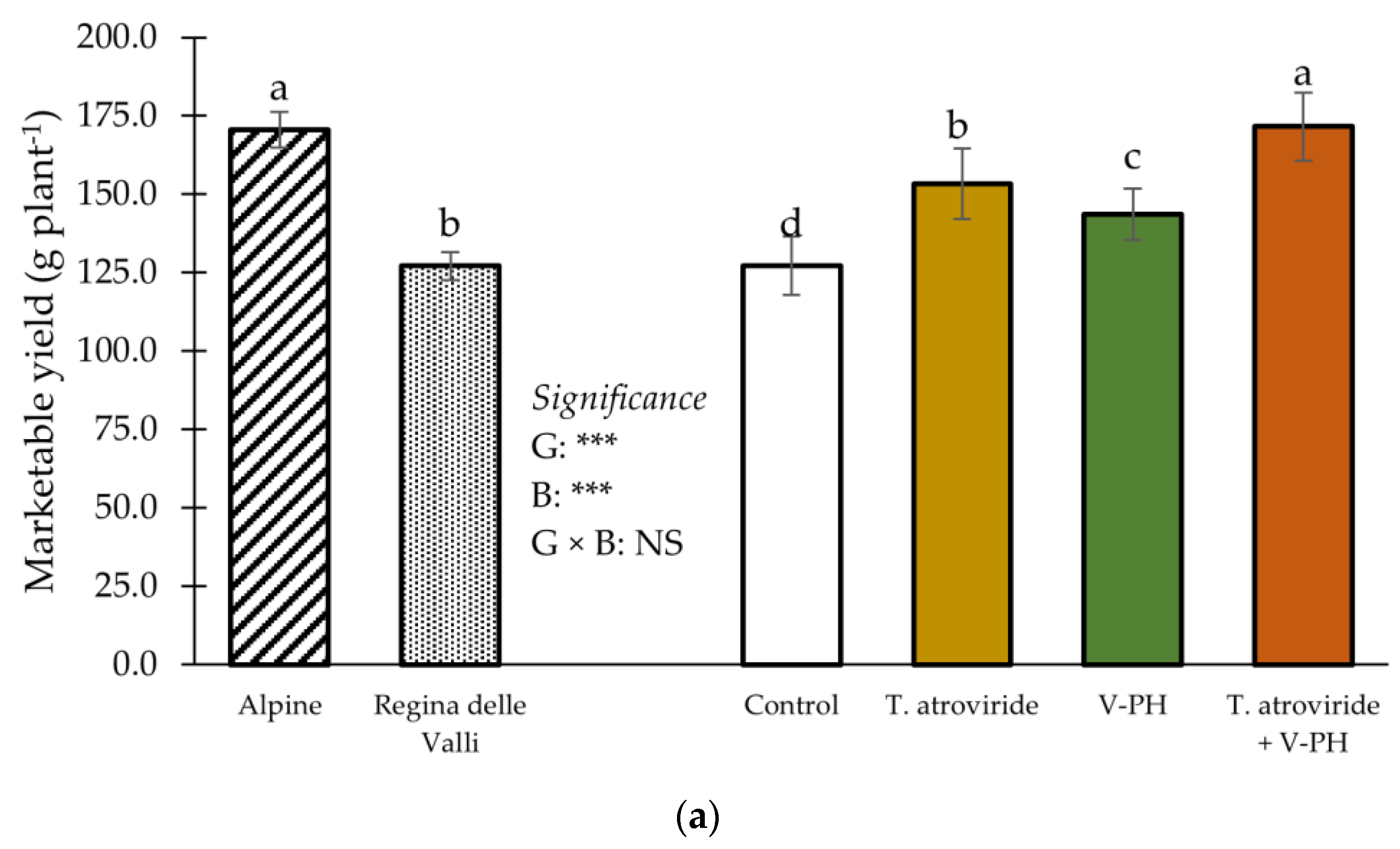
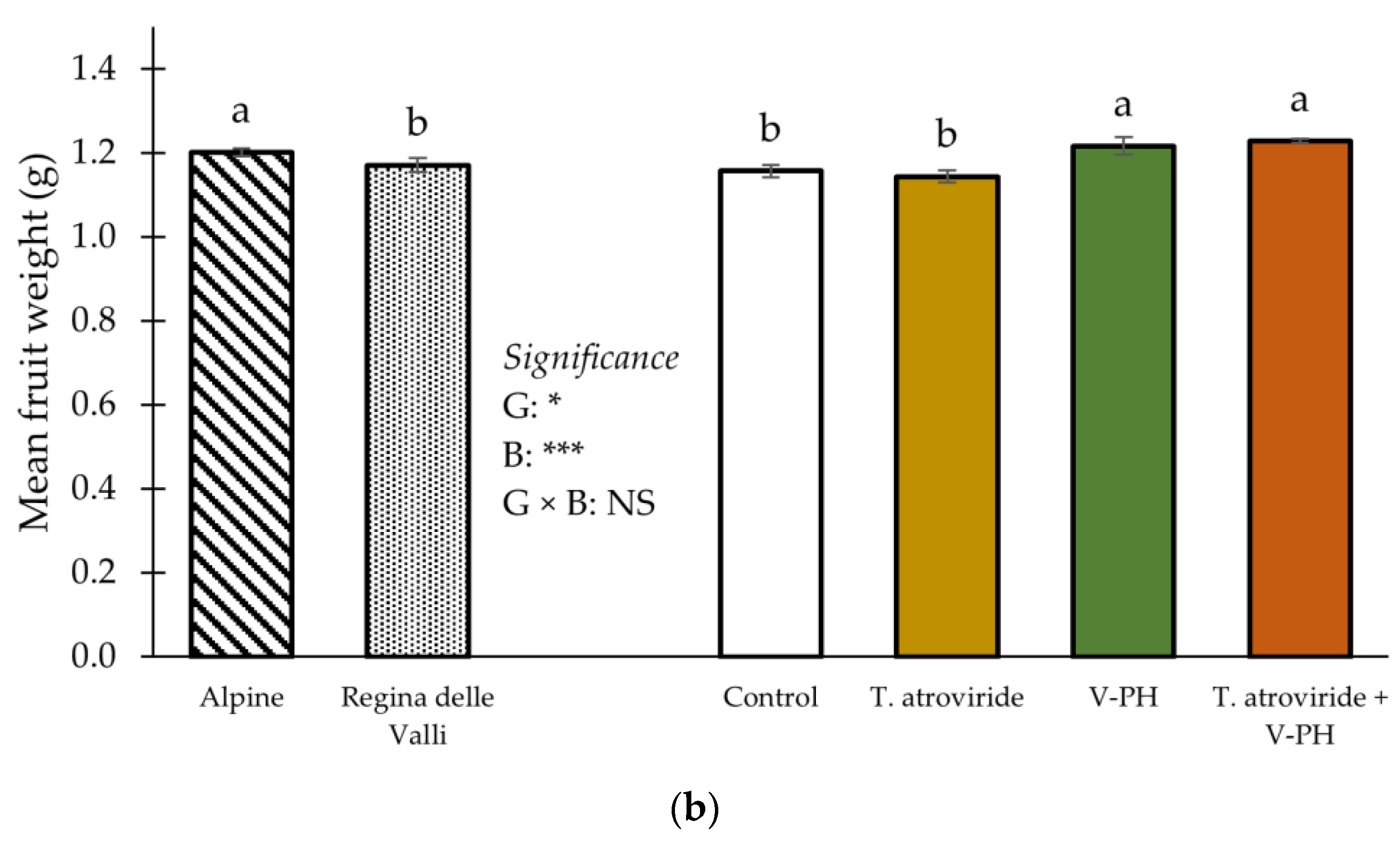
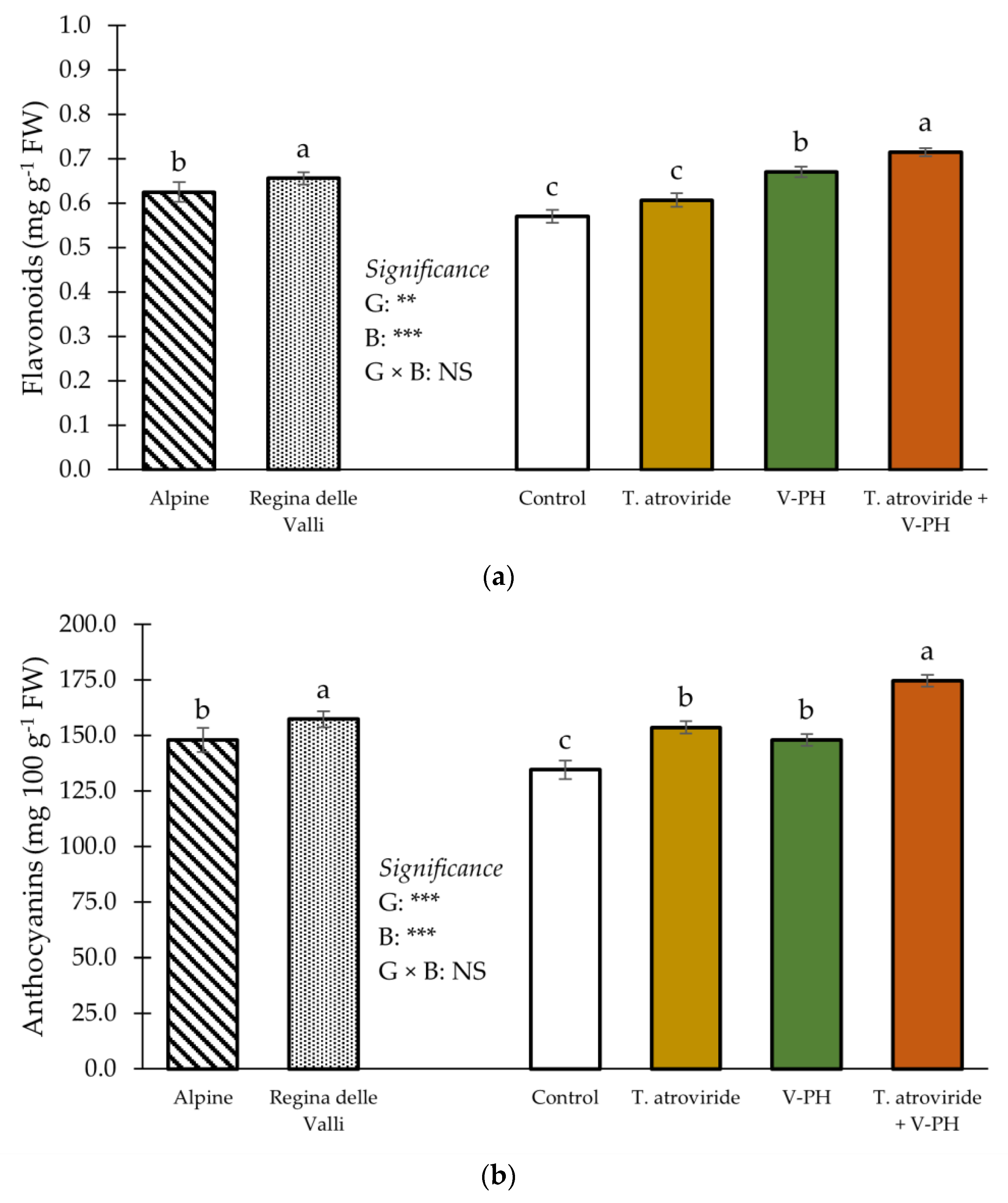
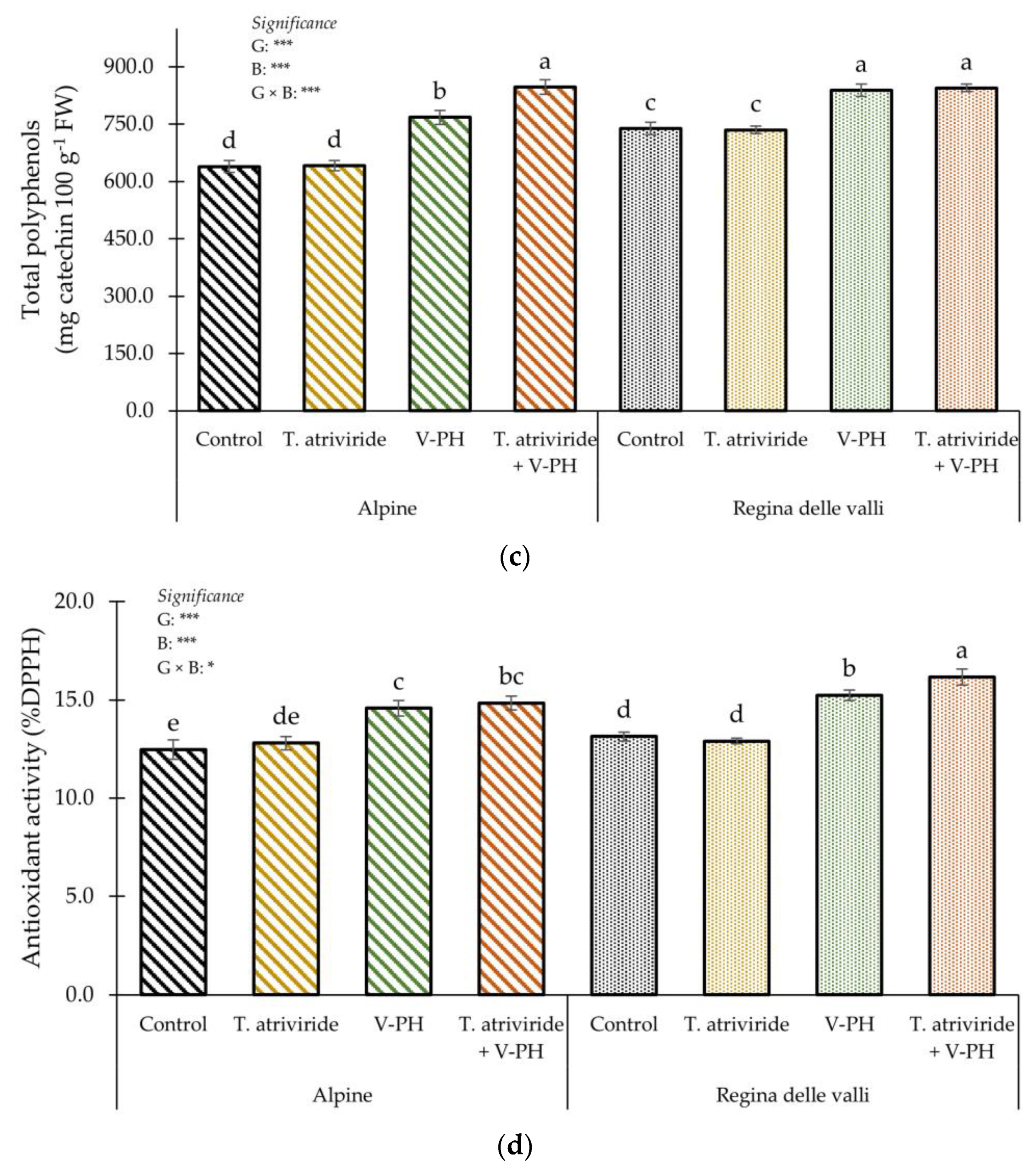
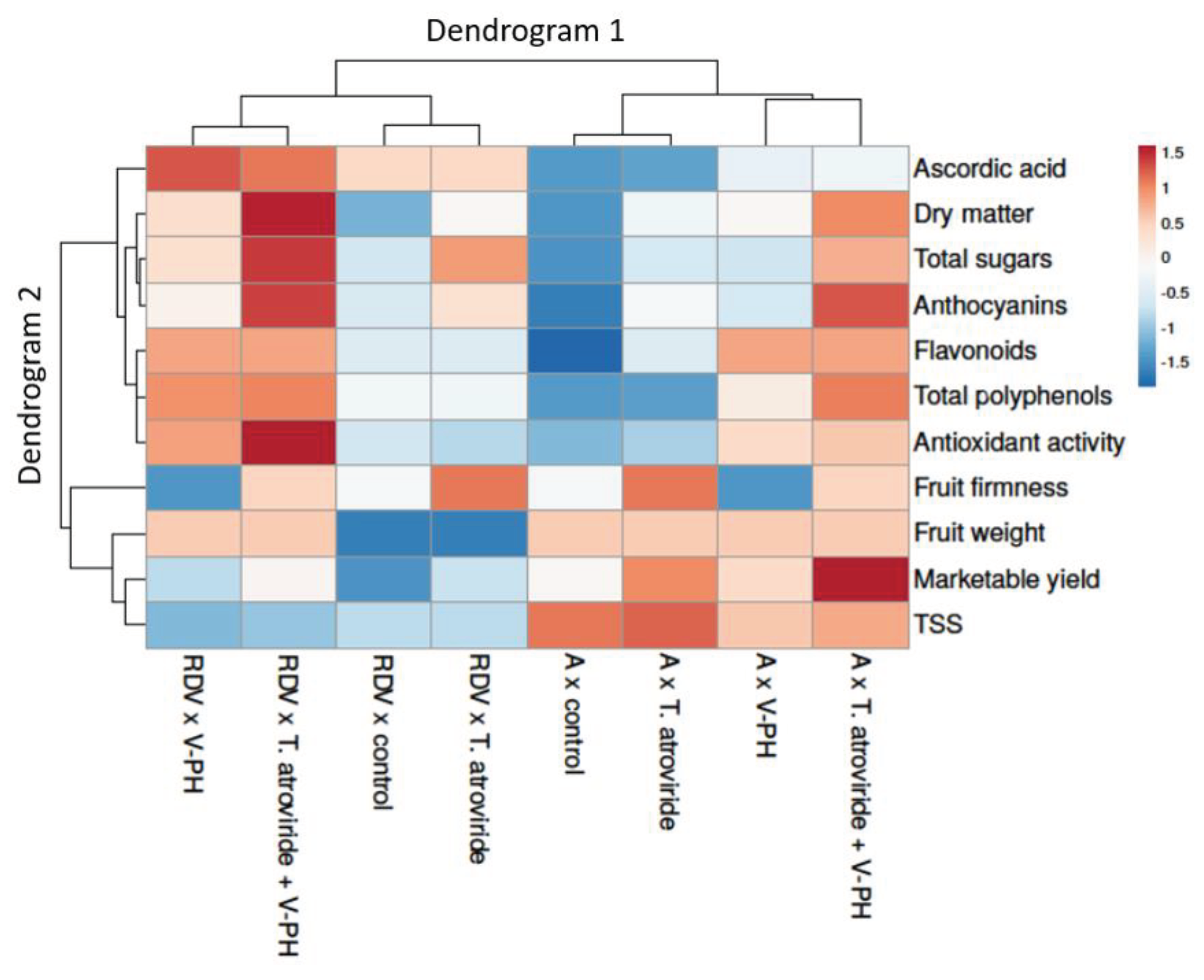
| Treatments | Fruit dry matter (%) | Fruit firmness (N) | TSS (°Brix) | Total sugars (mg 100 g-1 fw) | Ascorbic acid (mg 100 g-1 fw) | |||||
|---|---|---|---|---|---|---|---|---|---|---|
| Genotype (G) | ||||||||||
| Alpine | 32.3 | b | 1.13 | a | 12.13 | a | 8715.1 | b | 18.8 | b |
| Regina delle Valli | 32.9 | a | 1.10 | b | 10.39 | b | 8855.7 | a | 23.2 | a |
| Biostimulants (B) | ||||||||||
| Control | 30.5 | c | 1.11 | c | 11.42 | a | 8638.6 | c | 19.7 | b |
| T. atriviride | 32.3 | b | 1.27 | a | 11.45 | a | 8805.6 | b | 19.9 | b |
| V-PH | 32.9 | b | 0.90 | d | 11.02 | b | 8760.5 | b | 22.3 | a |
| T. atriviride + V-PH | 34.7 | a | 1.17 | b | 11.15 | b | 8937.0 | a | 22.2 | a |
| Significance | ||||||||||
| G | ** | * | *** | *** | *** | |||||
| B | *** | *** | *** | *** | *** | |||||
| G × B | NS | NS | NS | NS | NS | |||||
| Biostimulant | Yield Increase (kg ha-1) |
Price (€ kg-1) | Added Gross Return (€ ha-1) | Added Variable Cost (€ ha-1) | Added Net Return (€ ha-1) | |||
|---|---|---|---|---|---|---|---|---|
| Biostimulant Treatment | Application | Harvest | Total | |||||
| T. atroviride | 391.5 | 21.0 | 8221.5 | 150.0 | 70.0 | 1370.0 | 1590.0 | 6631.5 |
| V-PH | 246.0 | 21.0 | 5166.0 | 614.3 | 600.0 | 860.0 | 2074.3 | 3091.8 |
| T. atroviride + V-PH | 664.5 | 21.0 | 13954.5 | 764.3 | 670.0 | 2325.0 | 3759.3 | 10195.3 |
Disclaimer/Publisher’s Note: The statements, opinions and data contained in all publications are solely those of the individual author(s) and contributor(s) and not of MDPI and/or the editor(s). MDPI and/or the editor(s) disclaim responsibility for any injury to people or property resulting from any ideas, methods, instructions or products referred to in the content. |
© 2024 by the authors. Licensee MDPI, Basel, Switzerland. This article is an open access article distributed under the terms and conditions of the Creative Commons Attribution (CC BY) license (http://creativecommons.org/licenses/by/4.0/).





